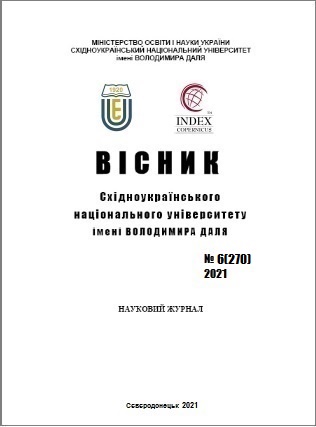Human capital of agrosector of domestic economy: problems of reproduction in aspect of food security
DOI:
https://doi.org/10.33216/1998-7927-2021-270-6-35-40Keywords:
human capital and its elements, agricultural sector, food security, innovative work, innovation-human capital, innovationAbstract
The basic and derivative elements of human capital, features of their formation in the agricultural sector of the domestic economy are investigated in the article. The analysis of scientific literature on the definition of the concept of "human capital" and its connection with other categories. The role of human capital of the agricultural sector of the economy in ensuring food security of the country is described. The institutional and economic structures of human capital are considered. Features of reproduction of human capital at individual (personal), cooperative (microeconomic) and national (macroeconomic) levels are described. The state of basic elements of human capital of agrosphere of domestic economy is analyzed.
Identified problems, the non-binding of which prevents the effective use of human capital, especially, the individual level of its organization. Such problems include: seasonality of production, a slow increase in the level of mechanization of agricultural labor, an increase in the number of unemployed youth in the village, migrating to the city, aging rural population with an undisputed level of education. It is shown that for the reproduction of human capital, it is necessary to create an innovative base for the formation of education, health, and life capital. It has been proven that the innovative base of human capital use should be based on attractive innovative labor. There are signs of attractive work, which include: high wages, technical labor, the presence of financial and information opportunities for workers to be involved in innovative programs and projects.
It is shown that increasing the level of human capital of the economically active population of the village, especially the youth, is an important factor in increasing the food security of the country. It is determined that the management of enterprises and state authorities should create conditions for innovative work of agricultural youth, which will help to solve the social problem of stopping the outflow of youth from the village; economic problem of increasing innovation activity of agribusiness enterprises; food problems of increasing the volume and nomenclature of agricultural products.
References
1. Беккер Г.С. Человеческое поведение. Экономический подход. Избранные труды по экономической теории. [Пер. с англ., науч. ред. послесловия Р.И. Капелюшников]. М.: ГУВШЭ, 2003. 472 с.
2. Сакайя Т. Стоимость, создаваемая знаниями, или история будущего. Новая индустриальная волна на Западе. М.: Academia, 1999. С. 337-371.
3. Злупко С.М., Радецький Й.І. Людський потенціал, зайнятість і соціальний захист населення в Україні; ред. М.М. Маpтиняк. Львів: Видавничий центр ЛНУ ім. І. Франка, 2001. 191 с.
4. Колот А., Григорович С. Соціально-трудові аспекти забезпечення стійкого розвитку національної економіки. Україна: аспекти праці. 2006. № 4. С. 8–15;
5. Ящук Т.А. Сутність концепції людського капіталу. Сталий розвиток економіки. 2013. № 4(21). С. 71–75.
6. Грішнова О.А. Людський, інтелектуальний і соціальний капітал України: сутність взаємозв’язок, оцінка, напрями розвитку. Соціально-трудові відносини: теорія та практика. 2014. № 1. С. 34–40.
7. Коломієць В.М. Інституціональна структура людського капіталу. Проблеми і перспективи економіки та управління. 2019. № 1(17). С. 26-32.
8. Носик О.М. Форми людського капіталу: головні підходи до визначення. Вісник Національного університету «Юридична академія України імені Ярослава Мудрого». Серія: Економічна теорія та право / редкол.: А. П. Гетьман та ін. Х.: Право, 2014. № 3 (18). С.149-156.
9. Точиліна Ю. Ю. Роль людського капіталу в інноваційному розвитку національної економіки. Науковий вісник Ужгородського національного університету. 2019. Випуск 26. Частина 2. С.88-91.
10. Захарова О.В. Розвиток класифікації показників оцінки ефективності інвестицій у людський капітал. Бюлетень Міжнародного Нобелівського економічного форуму. 2010. № 1(3). Т. 2. С. 123-131.
11. Кундєєва Г.О., Решетник Н.І., Хусаінов Р.В. Людський капітал в контексті інноваційного розвитку економіки України. Інвестиції: практика та досвід. 2013. № 24. URL: http://www.investplan.com.ua/index.php?op=8&w=%D0%93.+%D0%9E.+%D0%9A%D1%83%D0%BD%D0%B4%D1%94%D1%94%D0%B2%D0%B0 (дата звернення: 09.10.2021 ).
12. Гальків Л.І., Миськів Г.В., Килин О.В. Інноваційний людський капітал: проблеми фінансування. Управління інноваційним процесом в Україні: проблеми комерціалізації науково-технічних розробок: тези доповідей VІІ Міжнародної науково-практичної конференції, 17–19 травня 2018 року, Львів. Львів: Видавництво Львівської політехніки, 2018. С. 34–36.
13. Богдан О. Д. Концептуальна модель інноваційного розвитку аграрного сектору економіки України. Наукові праці НДФІ. 2017. № 2. (79). С. 65-76. URL: https://scholar.google.ru/citations?user=mYvJXQkAAAAJ&hl=ru&oi=sra (дата звернення 10.10.2021).
14. Вініченко І.І., Лапа В.О. Особливості формування та розвитку інтелектуального капіталу аграрних підприємств. Економіка і держава. 2020. №4. с. 85-90. DOI: 10.32702/2306-6806.2020.4.85. (дата звернення: 10.10.2021).
15. National Innovation Agenda Report. URL: https://agenda-report.agrohub.ua/ (дата звернення 09.10.2021).
16. Шебаніна О. В., Кормішкін Ю.А. Сучасна парадигма інноваційного розвитку аграрного підприємництва. Вісник аграрної науки Причорномор’я. 2019. Вип. 3(103). С.4-10. URL: http://dspace.mnau.edu.ua/jspui/bitstream/123456789/6589/1/n103v3r2019shebanina.pdf (дата звернення: 11.10.2021).
17. Ковальчук В., Шахно А. Інвестування в людський капітал як фактор інноваційного розвитку економіки України. Соціально-економічні проблеми і держава. 2016. Вип. 2 (15). С. 33-40.
18. Ширяєва Н.Ю. Інноваційно-людський потенціал у менеджменті будівельної галузі. Інфраструктура ринку. 2021. Випуск 52. С.126-130.
19. Герасименко О.О. Інноваційна праця: особливості змісту та соціально-економічної форми. Економіка та підприємництво: зб. наук. праць молодих учених та аспірантів / М-во освіти і науки України, ДВНЗ «Київ. нац. екон. ун-т ім. В. Гетьмана», 2008. Вип. 20. С. 210-219.
20. Чижова Н.Є. Новітні форми інноваційної праці у контексті розвитку людського капіталу. Глобальні та національні проблеми економіки. 2015. Випуск 8. С. 897-900.
21. Aгротехнології-2017: чим дивували світ українські розробники. url: agravery.com: https://agravery.com/uk/posts/show/agrotehnologii-2017-cim-divuvali-svit-ukrainski-rozrobniki (дата звернення: 11.10.2021).

